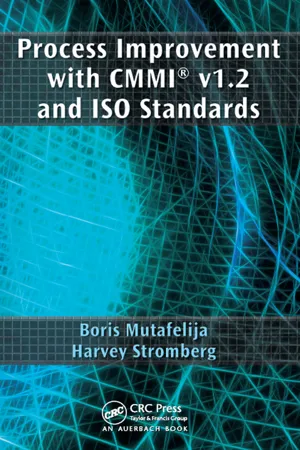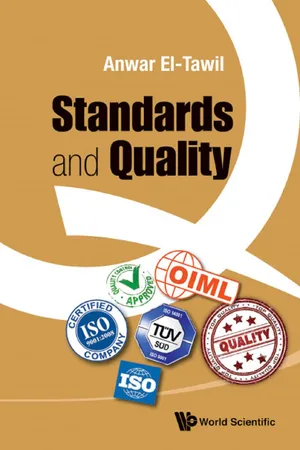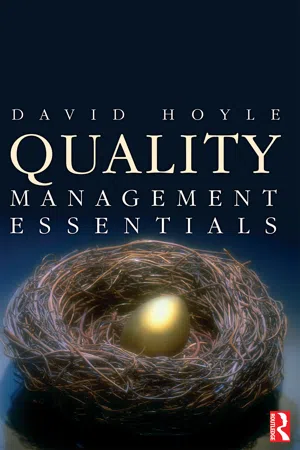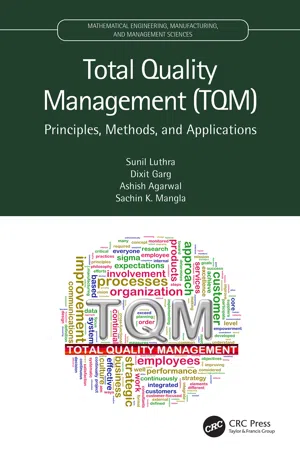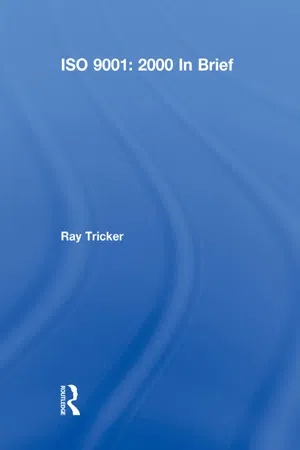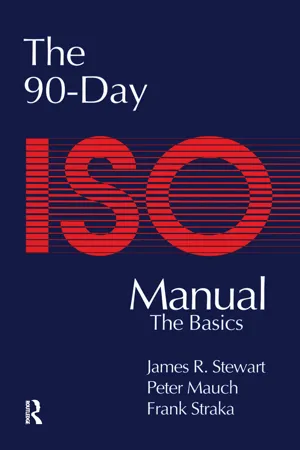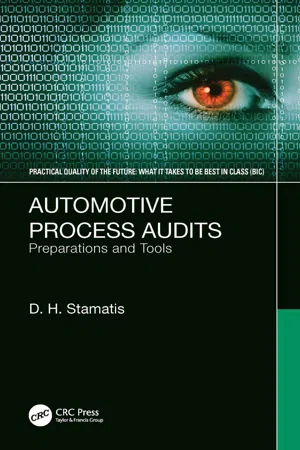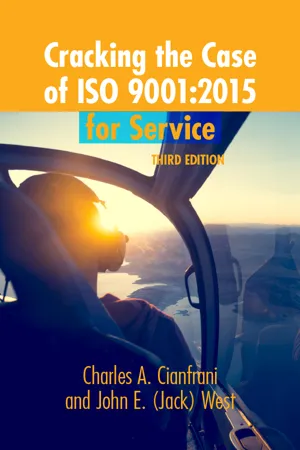Technology & Engineering
ISO 9000
ISO 9000 is a set of international standards for quality management systems. It provides guidelines and criteria for companies to ensure that their products and services consistently meet customer requirements and regulatory standards. Compliance with ISO 9000 can enhance a company's reputation, improve customer satisfaction, and increase operational efficiency.
Written by Perlego with AI-assistance
Related key terms
Related key terms
1 of 4
Related key terms
1 of 3
10 Key excerpts on "ISO 9000"
- Boris Mutafelija, Harvey Stromberg(Authors)
- 2008(Publication Date)
- Auerbach Publications(Publisher)
Chapter 4ISO Standards
Introduction
In this chapter we will summarize the content and structure of the following ISO standards for quality management, software engineering processes, systems engineering processes, and information technology service delivery:■ ISO 9001:2000,Quality management systems – Requirements (ISO 2000b)■ ISO 90003:2004,Guidelines for the application of ISO 9001:2000 to computer software (ISO 2004a)■ ISO 15288:2008,Systems and software engineering – System life cycle processes (ISO 2008a)■ ISO 12207:2008,Systems and software engineering – Software life cycle processes (ISO 2008b)■ ISO 20000:2005,Information technology – Service management (ISO 2005a)ISO, the International Organization for Standardization, was formed in the mid-1940s with the goal of unifying international industrial standards. ISO has published more than 16,000 standards, most of which are narrowly focused on specific technical criteria. In contrast to the bulk of ISO standards, ISO 9000:2000, Quality management systems – Fundamentals and vocabulary (ISO 2000a), probably the best known ISO standard, is a generalized standard for quality management systems. A quality management system defines the activities an organization performs to ensure that its products and services meet the needs and expectations of its customers. As such, ISO 9000 is intended to be applicable to organizations of all sizes and types, no matter what types of products and services those organizations provide.ISO 9000, shown in Figure 4.1- eBook - ePub
Total Quality Management
Text, Cases, and Readings, Third Edition
- Joel E. Ross(Author)
- 2017(Publication Date)
- Routledge(Publisher)
12 ISO 9000 AND ISO 14000:UNIVERSAL STANDARDS OF QUALITY Companies can comply with Europe’s standards — or stay home Business Week International standards had their origin in World War II when military allies needed to adopt some common units of measure and product specifications for munitions, vehicles, and military hardware. These later became known as MilSpecs. Even today, many standards are the descendants of these early standards. Industry followed the lead of the military, but industries in each country developed their own standards, and the result was incompatibility across boundaries. With the exception of ISO 9000 and ISO 14000, the majority of ISO standards are highly specifically documented agreements that contain technical specifications of other precise criteria to be used consistently as rules, guidelines, or definitions of characteristics to ensure that material, products, processes, and services are fit for their purposes. The focus is on the product, and before ISO 9000 and ISO 14000, the ISO standards were principally of concern to engineers and other technical specialists. For example, standards for items such as bolts, nuts, screws, pins, and rivets are essential to keep products from falling apart but are of interest primarily to technical personnel. The science of quality control emerged as the technique to ensure that standards were met, and the technique was confined almost exclusively to manufacturing. During the 1970s and 1980s, quality control evolved from reactive (inspection-dominant) to proactive (system-oriented) organizations. 1 The focus changed the end result (the product) to the process by which it was produced. The theory behind this change was that if the process used to produce the product was developed and maintained properly, the product would be consistent and the quality could be improved. This, of course, is one of the main tenets of total quality management (TQM) as described in this book - eBook - ePub
- Anwar El-Tawil(Author)
- 2014(Publication Date)
- WSPC(Publisher)
A fourth situation also exists, where an organization or a corporation decides to use the principles of ISO 9000 standards to improve the quality of its products and services, but is not interested in certification. In this case, the organization should implement the approaches and techniques provided in the ISO 9004 standard, which gives guidance on a wider range of objectives of a quality management system than does ISO 9001, particularly in managing for the long-term success of an organization. ISO 9004 is recommended as a guide for organizations whose top management wishes to extend the benefits of ISO 9001 in pursuit of systematic and continual improvement of the organization’s overall performance. However, ISO 9004 is not intended for certification or contractual purposes.It is worthwhile reminding the reader that, ISO 9001 prescribes Quality System Requirements, which are distinct from the Technical Requirements of Product and Technical Requirements of Processes. The three sets of requirements are complimentary, but neither can replace the others.7.5 IMPLEMENTATION OF ISO 9000 IN THE WORLDSince the first ISO 9000 standards were published in 1987, a spectacular increase in the number of organizations implementing them and obtaining certification was witnessed. By the end of 2013, over 1.1 million organizations have been certified to ISO 9001 in 170 countries (Figure 11 - eBook - ePub
- David Hoyle(Author)
- 2007(Publication Date)
- Routledge(Publisher)
However, it is important to recognize that there is no requirement in ISO 9000 for certification. The family of standards can be used in helping an organization discover the right things to do as well as assess for itself the extent to which its goals and processes meet international standards. Only where customers are imposing ISO 9001 in purchase orders and contracts would it be necessary to obtain ISO 9001 certification.Anatomy of the standards
There are three standards in the ISO 9000 family- ISO 9000 Quality management systems – Fundamentals and vocabulary
- ISO 9001 Quality management systems – Requirements
- ISO 9004 Quality management systems – Guidelines for performance improvements.
Each of the standards has a different purpose, intent, scope and applicability as indicated in Table 4.1 .These standards provide a vehicle for consolidating and communicating concepts in the field of quality management that have been approved by an international committee of representatives from national standards bodies. It is not their purpose to fuel the certification, consulting, training and publishing industries. The primary users of the standards are intended to be organizations acting as either customers or suppliers. But we should not forget that their primary purpose is to improve the capability of organizations to satisfy their customers and other stakeholders. Broken promises create massive problems for society thus making quality key to survival.Basic approach
The most important clause in ISO 9000 is clause 2.3. There is a clause 2.3 in ISO 9000 but not in ISO 9001 and just because it is not in ISO 9001 doesn't mean you should ignore it. All three standards are equally important because they depend on each other. The principles, concepts and terminology that underpin ISO 9001 are addressed by ISO 9000 and those aspects that apply beyond product conformity are addressed by ISO 9004. - eBook - ePub
Total Quality Management (TQM)
Principles, Methods, and Applications
- Sunil Luthra, Dixit Garg, Ashish Agarwal, Sachin K. Mangla(Authors)
- 2020(Publication Date)
- CRC Press(Publisher)
Numerous analysts worked to recognise the effect of ISO 9000 certification on an organisation, and most of them have identified significant financial benefits for ISO 9000 certified organisations. The British Assessment Bureau conducted a survey in 2011, and found that 44% of ISO certified organisations had won new business. ISO 9000 certified organisations achieved better returns when compared with the similar organisations without certification.Implementing ISO 9000 in any organisation is thought to be a guarantee of better financial performance, but a few researchers reported that while there is some evidence of this, the improvement is somewhat driven by the fact that the better performing companies have a tendency to pursue an ISO 9000 certificate.10.3.1 ISO 9000 VS ISO 9001ISO 9000 is a group of international quality management standards, whereas ISO 9001 is a member standard within the ISO 9000 family. Also there is a standard named ISO 9000 within the ISO family. This standard establishes the basics and terminology for quality management systems.10.4 EVOLUTION OF THE ISO 9000 QUALITY MANAGEMENT STANDARDS
Professionals implementing the ISO 9000 quality management standards give their feedback and based on their feedback, standing technical committees and advisory groups revise the ISO 9000 standard. The various editions of ISO 9000 are given below.10.4.1 ISO 9001:1987 EDITIONISO 9000:1987 was developed on the basis of UK Standard BS-5750. It has three ‘models’ for quality management systems based on the activities of the organisation. The three models of this edition are given here:10.4.2 ISO 9001:1987 MODELThis model was used for assuring quality in design and development, production, installation, and after-sales servicing. So the organisations involved in developing new products were best suited for this model.10.4.3 ISO 9002:1987 MODELThis model was used for assuring quality in production, installation, and servicing. So the organisations involved in production, installation, and servicing work, but not involved in the creation of new products, should register under this model. - eBook - ePub
- Bruce Sherring-Lucas(Author)
- 2005(Publication Date)
- Routledge(Publisher)
The ISO 9000:2000 family of standards consists of three primary standards. These are:ISO 9000:2000 Quality Management Systems – Fundamentals and vocabulary (superseding ISO 8402:1994 ‘Quality Management and Quality Assurance – Vocabulary’ and ISO 9000–1:1994 ‘Quality Management and Quality Assurance Standards – Guidelines for selection and use’).Describes fundamentals of QMSs which forms the subject of the ISO 9000 family, and defines related terms.ISO 9001:2000 Quality Management Systems – Requirements (superseding ISO 9001:1994 ‘Quality Systems – Model for quality assurance in design, development, production, installation and servicing’, ISO 9002:1994 ‘Quality Systems – Model for quality assurance in production, installation and servicing’ and ISO 9003:1994 ‘Quality Systems – Model for quality assurance in final inspection and test’).Specifies the requirements for QMSs for use where an organisation’s capability to provide products that meet customer and applicable regulatory requirements needs to be demonstrated.Figure 5.7 The ISO 9001:2000 familyISO 9004:2000 Quality Management Systems – Guidelines for performance improvement (superseding ISO 9004–1:1994 ‘Quality Management and Quality System Elements – Guidelines).Provides guidance on QMSs, including the processes for continual improvement that will contribute to the satisfaction of an organisation’s customers and other interested parties. For completeness, a new standard has been written to assist auditing systems against ISO 9001:2000, this is:ISO 19011 Guidelines on auditing quality and environmental management systems - D.H. Stamatis(Author)
- 2018(Publication Date)
- Routledge(Publisher)
tested in at the end of the development cycle. Prototyping and other automated techniques of describing and demonstrating or simulating user requirements are available and increasingly being used across the software development industry.Along with these efforts we now have the opportunity to use the ISO 9000 registration process to improve software quality and usability. But to do that requires that the original quality system process as written in ISO 9001 be adapted, since ISO 9001 was written without software in mind. This was the reason ISO 9000–3 was written: to give guidance on how to apply ISO 9001 to software. This is now official ISO guidance, which should be used in quality systems and audits where software is the product or to the extent it affects the quality of the service or the product delivered to the customer.RELATIONSHIPS AMONG ISO 9001, ISO 10011, AND ISO 9000–3
One of the great advantages of the ISO 9000 series standards is that they are generic and can be applied to any industry anywhere. In the United States currently, the ISO 9000 registration now in place is generic. The United States, for all intents and purposes, does not have any programs for a specific industry—as of September 1, 1994, the automotive industry developed such a program and called it QS 9000 quality system (such programs are called sector programs). Although the system in place in the United States does require that registrars and auditors carry out audits to ISO 10011 using competent auditors, there is no specific requirement for software workplace experience and training. Something is needed to specify qualifications to account for the differences that exist between auditing software development processes and other industrial processes. ISO 9000–3 is used to translate ISO 9001 into the language of computer software developers and users. A comparison between ISO 9001 and ISO 9000–3 is shown in Table 8.1- eBook - ePub
- Peter Mauch, James Stewart, Frank Straka(Authors)
- 2023(Publication Date)
- CRC Press(Publisher)
To describe these quality management practices, the standard utilizes a group of seven categories. These seven categories provide the basis for the organization of the standard and are titled:- Management leadership
- Quality information system and results
- Utilization of people
- Customer needs identification
- Service, product and process development
- Operations
- Quality improvement
1.2 Purpose
This standard provides guidelines for developing, implementing, maintaining, and improving a quality management system.1.3 Application
The quality system should be structured and adapted to the organization's particular type of business and should take into account the appropriateness of categories as outlined herein. Each element within a category should be reviewed to determine its applicability to a given business.In order to consistently achieve maximum effectiveness and to satisfy customer expectations, it is essential that the quality management system be (1) deployed throughout the business and (2) integreated with business strategy.Total quality management and/or quality systems is the application of the model specified in this standard to all aspects/parts of the organization.2 NORMATIVE REFERENCES
IEC 300: Reliability Management ANSI/IEEE 730: Software Quality Assurance Plans ANSI/ASQC Q1: Generic Guidelines for Auditing of Quality Systems ANSI/ASQC M1-1987: Calibration Systems ANSI/ASQC (TBD): Guide for Formal Design Review ANSI/ASQC Q90 ANSI/ASQC Q91 ANSI/ASQC Q92 - eBook - ePub
Automotive Process Audits
Preparations and Tools
- D. H. Stamatis(Author)
- 2021(Publication Date)
- CRC Press(Publisher)
Clause 7.5 requires you establish and use documented procedures to “maintain documented information to the extent necessary to support the operation of processes and retain documented information to the extent necessary to have confidence that the processes are being carried out as planned.” For some businesses, the “extent necessary” may mean once a year. Others may only choose to go through the process once every 2 or 3 years. What is important here is to remember that when working through your obligation under clause 7.5, you need processes to- Approve documents
- Review, update, and submit documents for re-approval
- Identify changes
- Make documents available
- Ensure documents are legible and identifiable
- Identify and control external documents
- Keep obsolete documents out of circulation
- Identify obsolete documents as necessary if retained.
- Identifying records
- Storing records
- Protecting records (including keeping them identifiable and legible)
- Retrieving records
- Retaining records
- Disposing of records.
Conclusion
The two most important objectives of the ISO 9001:2015 update is to develop a simpler set of standards that apply to all organizations and to allow organizations to focus on the most relevant documentation for their business activities. Therefore, as management of the organization it is very important to recognize most of the documented information from the list of requirements above. Your goal then is to standardize it and supplement it with the other documented information that will help your QMS work.ISO 14000
General Comments
ISO 14000 is similar to ISO 9000 quality management in that both pertain to the process of how a product is produced, rather than to the product itself. Specifically, however, ISO 14000 is a family of standards related to environmental management that exists to help organizations (a) minimize how their operations (processes, etc - eBook - ePub
Cracking the Case of ISO 9001:2015 for Service
A Simple Guide to Implementing Quality Management in Service Organizations
- Charles A. Cianfrani, John (Jack) E. West(Authors)
- 2015(Publication Date)
- ASQ Quality Press(Publisher)
Quality management systems—Fundamentals and vocabulary . This means, as we previously indicated, that the terms and definitions in ISO 9000:2015 shall be applied and used when developing, creating documented information, and deploying processes related to ISO 9001:2015.We strongly encourage all users of ISO 9001 to obtain a copy of ISO 9000:2015. Clause 3 Terms and Definitions The standard simply states that the terms and definitions given in ISO 9000:2015 apply. Clause 4 Context of the organization Clause 4.1 Understanding the organization and its contextWhat Is the Requirement?This clause requires the organization to be thinking at both the strategic and tactical levels. This implies continuous thought about external and internal issues that are relevant to its purpose and its strategic direction. Neither “big picture” thinking nor detailed analysis is sufficient by itself. This clause mandates consideration of the internal and external issues that affect the ability of the organization to achieve its intended results when it develops and deploys its QMS.
Index pages curate the most relevant extracts from our library of academic textbooks. They’ve been created using an in-house natural language model (NLM), each adding context and meaning to key research topics.
Explore more topic indexes
Explore more topic indexes
1 of 6
Explore more topic indexes
1 of 4
